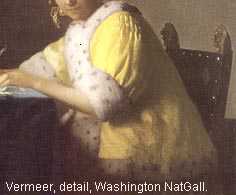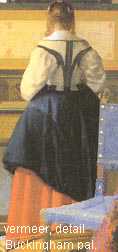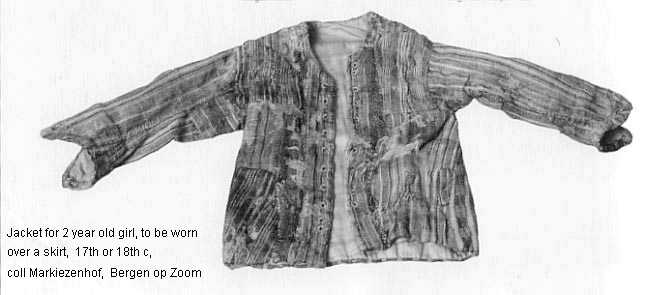Jacket, woman's suit (mantel)
 A
yellow satin jacket or woman's suit with white fur edges 'Een
geele zatyne mantel met witte bonte kanten', in the Great Hall,
room I. This jacket was worn above a layer of linen clothes (as linen
could be washed and fur couldn't), The furry edge is probably made of
white squirrel or cat skin.
A
yellow satin jacket or woman's suit with white fur edges 'Een
geele zatyne mantel met witte bonte kanten', in the Great Hall,
room I. This jacket was worn above a layer of linen clothes (as linen
could be washed and fur couldn't), The furry edge is probably made of
white squirrel or cat skin.
Stays 'lijfjes' which were tightly tied with laces, were
worn under the jacket. They were often red in colour, with some lace
work on the front. The term used in Amsterdam was "rijglijven" and in
Delft "keurslijven" (Marieke de Winkel, 1998, p. 329).
See the discussion of the term Turkish
Mantle.
 To
the left a yellow woman's suit with black ribbon. We find this one on
five paintings, of which one is The Music lesson (Buckingham
Palace). The suit was usually worn over a skirt. It was pulled up and
attached to both sides and was therefore called 'schort'.
(Marieke de Winkel, 1998, p. 329-330)
To
the left a yellow woman's suit with black ribbon. We find this one on
five paintings, of which one is The Music lesson (Buckingham
Palace). The suit was usually worn over a skirt. It was pulled up and
attached to both sides and was therefore called 'schort'.
(Marieke de Winkel, 1998, p. 329-330)
The b/w illustration below shows a jacket with lace holes, an
garment for a 2 year old girl which was to be worn over a skirt. This
dress was common in the seventeenth and eighteenth century for adult
women in the southern Dutch province of Noordbrabant. Coll. Het
Markiezenhof, Bergen op Zoom.
Marieke de Winkel* noted that this garment was called 'jak' in
Amsterdam and 'manteltje' in Delft, Dordrecht and Rotterdam. Both
terms were translated as"jacket" in a 1691 dictionary. The term "jak"
refers to a woman's garment ; it was also used as a garment for
working women and maids. It was popular for maids to dress
fashionably, which resulted in criticism in society.
Note : This object was part of the
Vermeer-inventory as listed by the clerk working for Delft notary
public J. van Veen. He made this list on February 29, 1676, in the
Thins/Vermeer home located on Oude Langendijk on the corner of
Molenpoort. The painter Johannes Vermeer had died there at the end of
December 1675. His widow Catherina and their eleven children still
lived there with her mother Maria Thins.
The transcription of the 1676 inventory, now
in the Delft archives, is based upon its first full publication by
A.J.J.M. van Peer, "Drie collecties..." in Oud Holland 1957,
pp. 98-103. My additions and explanations are added within square
brackets [__]. Dutch terms have been checked against the
world's largest language dictionary, the Dictionary of the Dutch
Language (Woordenboek der Nederlandsche Taal , or WNT),
which was begun by De Vries en Te Winkel in 1882. In 2001 many
textile terms have been kindly explained by art historian Marieke de
Winkel.
 B/w
illustration from Kinderen van alle tijden, exh. cat .
Noordbrabants Museum, published by Waanders Zwolle/ Noordbrabants
Museum, Den Bosch 1997, ill. 121.
B/w
illustration from Kinderen van alle tijden, exh. cat .
Noordbrabants Museum, published by Waanders Zwolle/ Noordbrabants
Museum, Den Bosch 1997, ill. 121.
*Marieke de Winkel, 'The Interpretation of
Dress in Vermeer's Paintings' in Vermeer Studies, edited by
Ivan Gaskell and Michiel Jonker, National Gallery of Art, Washington
DC, 1998,327-339.
This page forms part of a large encyclopedic site on Vermeer and Delft. Research by Drs. Kees Kaldenbach (email). A
full presentation is on view at johannesvermeer.info.
Launched December, 2002; Last update March 2, 2017.
Back to the Welcome page: click Welcome.
 A
yellow satin jacket or woman's suit with white fur edges 'Een
geele zatyne mantel met witte bonte kanten', in the Great Hall,
room I. This jacket was worn above a layer of linen clothes (as linen
could be washed and fur couldn't), The furry edge is probably made of
white squirrel or cat skin.
A
yellow satin jacket or woman's suit with white fur edges 'Een
geele zatyne mantel met witte bonte kanten', in the Great Hall,
room I. This jacket was worn above a layer of linen clothes (as linen
could be washed and fur couldn't), The furry edge is probably made of
white squirrel or cat skin. To
the left a yellow woman's suit with black ribbon. We find this one on
five paintings, of which one is The Music lesson (Buckingham
Palace). The suit was usually worn over a skirt. It was pulled up and
attached to both sides and was therefore called 'schort'.
(Marieke de Winkel, 1998, p. 329-330)
To
the left a yellow woman's suit with black ribbon. We find this one on
five paintings, of which one is The Music lesson (Buckingham
Palace). The suit was usually worn over a skirt. It was pulled up and
attached to both sides and was therefore called 'schort'.
(Marieke de Winkel, 1998, p. 329-330) B/w
illustration from Kinderen van alle tijden, exh. cat .
Noordbrabants Museum, published by Waanders Zwolle/ Noordbrabants
Museum, Den Bosch 1997, ill. 121.
B/w
illustration from Kinderen van alle tijden, exh. cat .
Noordbrabants Museum, published by Waanders Zwolle/ Noordbrabants
Museum, Den Bosch 1997, ill. 121.